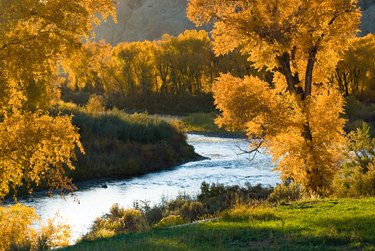
Growing to a height of 100 feet with grooved, gray bark, cottonwood trees (Populus spp.) are hardy from U.S. Department of Agriculture plant hardiness zones 3 through 11, depending on the species. Male cottonwoods have red flower spikes, called catkins, in spring while females produce yellow-green ones. The catkins are followed by triangular, toothed leaves varying in length from 2 1/2 inches for the western cottonwood (Populus fremontii, USDA zones 5 through 10) to up to 8 inches for the eastern cottonwood (Populus deltoides, USDA zones 3 through 11). The fluff filling the seedpods on female trees can become a messy nuisance but helps disperse the seeds. Following a particular procedure before, during and after planting cottonwood seeds helps them sprout.
Harvest the Seeds
Video of the Day
Cottonwood seeds should be planted as soon as possible after they mature, which usually happens four to six weeks after the trees flower. The green, 1/4- to 3/5-inch seed capsules, or seedpods, appear in dangling clusters on female cottonwoods and break open in late spring or early summer, revealing brown seeds that are about 1/10 inch long and surrounded by cottonlike fluff. Gather those seeds just after the pods open.
Video of the Day
Prepare Them
Removal of the cottony fluff helps the seeds adhere to their planting medium. You can try to get rid of the fluff by rubbing the seeds against the mesh of a screen or strainer, but it isn't always possible to remove the fluff without damaging the seeds.
Spread the seeds on a paper towel for three days to dry. If they still have fluff attached to them, then covering them with an additional paper towel may be necessary to prevent drafts from blowing the seeds away.
If you cannot sow the dried seeds right away, then place them in a capped glass jar in a refrigerator. Plant them as soon as possible, however, because even refrigerated seeds can lose their ability to sprout, or germinate, within one year.
Sow Them
When daytime temperatures have risen to 68 to 85 degrees Fahrenheit in late spring or early summer, choose a site to plant your cottonwood seeds. Look for a spot that receives full sun and has sandy loam. In nature, cottonwoods grow in the silty soil beside sources of fresh water, such as rivers and streams.
A brief immersion in water may help the seeds germinate faster than they would otherwise. Seeds of black cottonwood (Populus trichocarpa, USDA zones 7 through 10), for example, should be soaked for six hours and those of the eastern cottonwood for 24 hours. Strew the tiny seeds on the surface of the seedbed at the rate of about 300 seeds per 1 square foot, and water the site so they work their way into the soil.
Cover the planting site with a piece of lattice or snow fence, placing it horizontally atop supports that raise it 3 to 5 feet above the seedbed. The cover provides partial shade, prevent the site from becoming too hot or too dry. If the seeds' soil is kept damp, they should germinate quickly, usually in one to seven days.
Raise the Seedlings
Keeping the planting site watered very well for the first month after you plant the seeds is important because the resulting seedlings' roots are tiny. At the end of the first month, remove some of the seedlings, leaving about 20, evenly spaced seedlings per 1 square foot.
Keep the seedlings under the lattice or snow fence shade frame for their first summer, raising that cover as necessary to maintain its 3- to 5-foot distance above the plants' tops. When the weather cools in fall, gradually begin removing the shade frame for longer and longer periods of time until the little trees receive full-sun exposure all day. When the trees grow larger but before they crowd each other, they need to be transplanted to stand at least 12 feet apart in a full-sun site.
- Woody Plant Seed Manual; U.S. Department of Agriculture, Forest Service
- Biology of Populus and its Implications for Management and Conservation; Reinhard Friedrich Stettler, Editor
- Seeds: The Ultimate Guide to Growing Successfully from Seed; Jekka McVicar
- North Dakota State University Extension Service: Questions on Cottonwood
- Sheffield's Seed Co.: Populus
- The Cottonwood Tree: An American Champion; Kathleen Cain
- Purdue University: Populus Deltoides Bartr. ex Marsh.